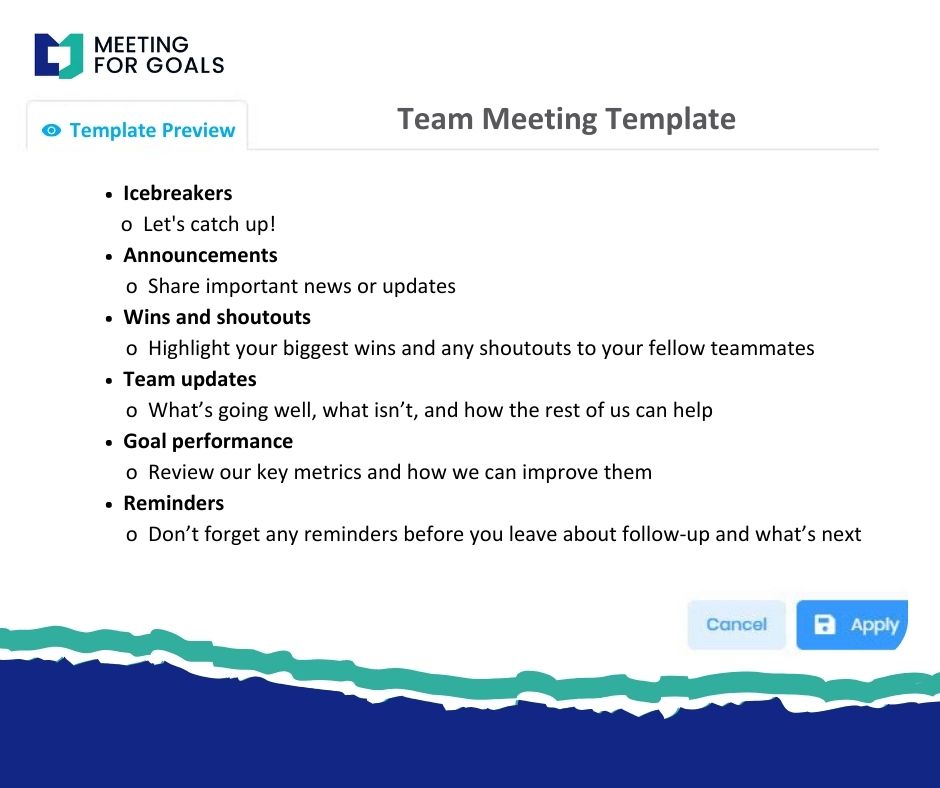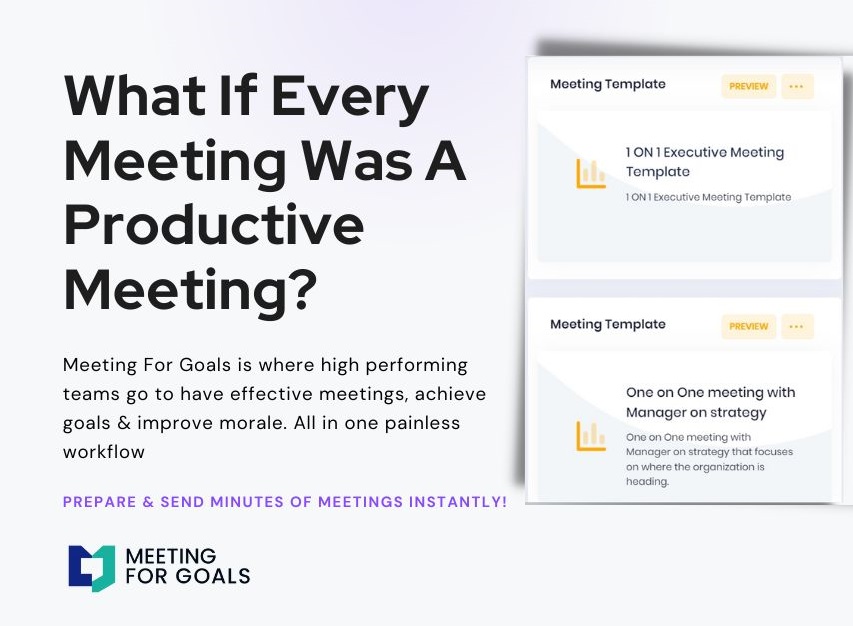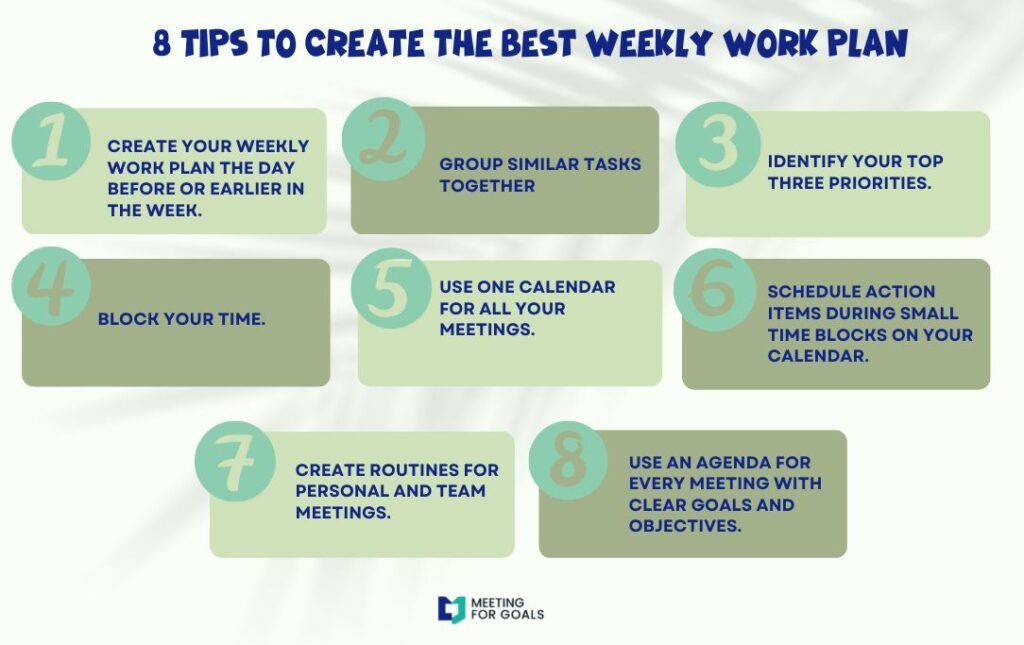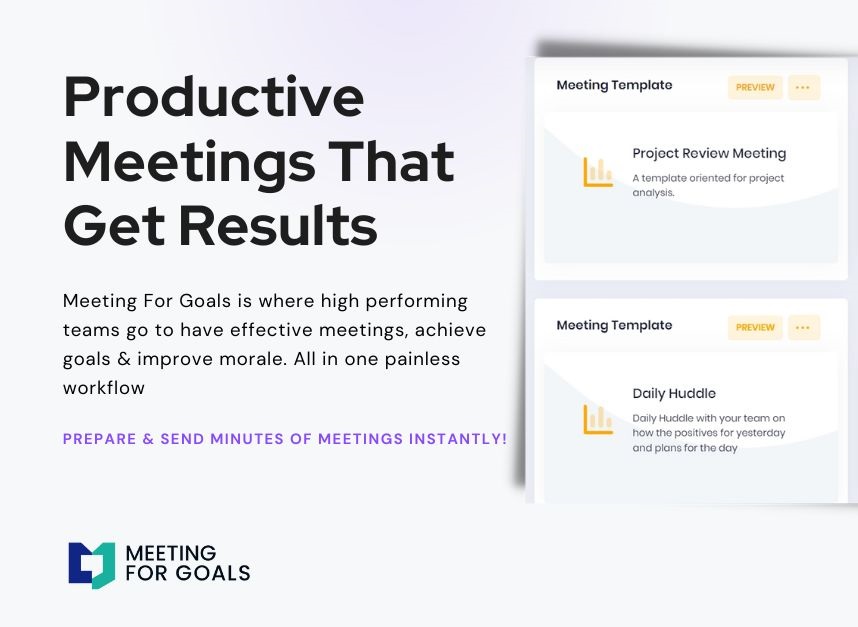Scrum Master vs. Project Manager: Understanding the Differences for More Effective Teams
Explore how goal-driven meetings can transform your team’s productivity. Sign up today at https://app.meetingforgoals.com/TenantRegistration/Register or check out our free meeting templates at https://meetingforgoals.com/meeting_templates.
In today’s fast-moving business world, delivering successful projects is more than just checking off tasks. It’s about aligning teams, making smart decisions, and ensuring that every meeting and milestone brings real value to the organization.
Whether you’re leading a product team or managing a cross-functional department, two roles often come into play: the Scrum Master and the Project Manager. Both are essential—but they operate differently. For companies with 40 to 70 employees, understanding these differences can make or break team performance.
Project management has come a long way. Traditional approaches like Waterfall used to dominate, putting Project Managers in charge of planning and execution. However, with Agile gaining popularity—especially in tech—Scrum Masters have become vital for keeping teams flexible and focused.
This article breaks down the key differences between Scrum Masters and Project Managers. We’ll explore their roles, the methodologies they use, and how tools like Meeting For Goals can help both lead more effective, goal-driven meetings.
By the end, you’ll have a clear understanding of which role fits your team’s needs—and how to empower both to work better, together.
2 Minute Video
Watch a 2 minute demo of our meeting management software in action
Defining the Roles
Scrum Master
A Scrum Master is a core player in Agile teams, especially those using the Scrum framework. Unlike traditional managers, Scrum Masters aren’t task assigners or decision-makers. Instead, they’re facilitators—helping teams stay on track and follow Agile principles.
They focus on making sure the team is working well together. This includes removing any roadblocks and guiding the team through regular Scrum ceremonies like sprint planning, daily stand-ups, and retrospectives.
Key responsibilities of a Scrum Master:
- Facilitating Scrum ceremonies
- Coaching the team on Agile practices
- Removing obstacles to progress
- Encouraging collaboration and transparency
Scrum Masters don’t hold authority over the team. They serve the team, helping it become more self-organized and productive over time.
Project Manager
Project Managers, on the other hand, are more traditional leaders. You’ll find them in all kinds of industries—including construction, marketing, IT, and more. Their job is to ensure a project gets completed on time, within budget, and according to plan.
They create schedules, manage resources, and communicate with stakeholders. Often, they have decision-making authority and are accountable for the project’s overall success.
Key responsibilities of a Project Manager:
- Defining project scope and goals
- Creating detailed plans and timelines
- Managing budgets and risks
- Reporting progress to stakeholders
While both roles aim to deliver successful outcomes, their day-to-day responsibilities and leadership styles are very different. Understanding these differences helps companies assign the right person to the right role—and improve how meetings are run and goals are met.
Adding an Agenda
How to add an agenda instantly on Meeting For Goals
Methodologies and Frameworks
Agile vs. Traditional Project Management
The biggest difference between Scrum Masters and Project Managers comes down to the methodology they follow.
Scrum Masters operate within Agile, a flexible, iterative approach to project work. Agile values collaboration, adaptability, and continuous feedback. Teams work in short cycles called sprints, delivering small pieces of the product and adjusting as they go.
Scrum is one of the most popular Agile frameworks. It includes specific roles (Scrum Master, Product Owner, Development Team), ceremonies (like sprint planning and retrospectives), and artifacts (like the product backlog).
Project Managers usually follow traditional project management methods, like the Waterfall model. This approach is linear: define the project, plan it, execute it, monitor it, and close it. Each phase must be completed before moving to the next.
Waterfall works well for projects with clear, unchanging requirements—think construction or manufacturing. Agile, on the other hand, is ideal for fast-paced environments where priorities shift often—like software development.
Scrum Framework in Action
Scrum is built around regular, structured meetings that keep the team aligned and focused. These meetings, or ceremonies, include:
- Sprint Planning: Deciding what the team will work on during the sprint
- Daily Stand-Ups: Quick updates on progress, plans, and blockers
- Sprint Review: Demoing completed work for feedback
- Sprint Retrospective: Reflecting on what went well and what could improve
The Scrum Master ensures these meetings are effective and that the team is working smoothly. They help eliminate distractions and promote open communication.
Project Managers also run meetings—but theirs are usually more formal. Think stakeholder updates, risk reviews, and progress check-ins. These meetings often follow a top-down structure.
This is where a tool like Meeting For Goals becomes a game-changer. Whether you’re running a Scrum retrospective or a traditional project update, Meeting For Goals helps keep meetings focused, goal-based, and efficient.
Want to streamline your next meeting? Try one of our free templates at https://meetingforgoals.com/meeting_templates.
Key Differences in Responsibilities
Leadership Style
Scrum Masters and Project Managers lead in very different ways.
Scrum Masters are servant-leaders. They don’t give orders or assign tasks. Instead, they support the team, guide them through Agile practices, and help them grow into a self-managing unit.
Project Managers lead in a more traditional, directive way. They assign tasks, set deadlines, and make decisions. This approach works well when clear direction and structure are needed.
Focus: Team vs. Project
Scrum Masters focus on the team. They care about how the team works together, how it communicates, and whether it’s improving over time. Their success is measured by team performance and the value delivered to the customer.
Project Managers focus on the project itself. They’re responsible for the “iron triangle” of scope, time, and cost. Their goal is to deliver the project as planned and keep stakeholders happy.
Stakeholder Engagement
Scrum Masters usually work closely with the Product Owner to make sure the team is building the right thing. They may interact with stakeholders, but they don’t manage them directly.
Project Managers are the main point of contact for stakeholders. They handle communication, set expectations, and provide updates. Their job is to keep everyone aligned and informed.
Both roles run meetings—but the structure and purpose of those meetings vary. Meeting For Goals helps both roles run better meetings by aligning agendas with company goals, tracking action items, and keeping teams accountable.
Skills and Qualities Needed
Scrum Master Skills
A great Scrum Master is more of a coach than a manager. They need strong people skills and a deep understanding of Agile principles.
Essential skills include:
- Facilitation: Leading effective daily stand-ups, retrospectives, and planning sessions
- Coaching: Helping the team embrace Agile values and improve over time
- Conflict Resolution: Navigating team dynamics and resolving issues
- Servant Leadership: Supporting the team without controlling it
Scrum Masters also need patience and empathy. They often help teams unlearn old habits and adopt a new way of working.
Project Manager Skills
Project Managers need a different skill set—one that’s more structured and process-oriented.
Key skills include:
- Planning: Creating detailed project schedules and plans
- Risk Management: Identifying potential problems and finding solutions
- Budgeting: Managing project costs and staying within budget
- Communication: Keeping stakeholders informed with clear, concise updates
Good Project Managers are organized, decisive, and results-driven. They know how to juggle multiple priorities and keep a team moving forward.
Shared Skills
Despite their differences, Scrum Masters and Project Managers do share some important skills:
- Communication: Both need to communicate clearly with teams and stakeholders
- Problem-Solving: Both must address challenges quickly and effectively
- Meeting Management: Both lead meetings that move the team toward its goals
That last one—meeting management—is often overlooked. But it’s critical. And that’s where Meeting For Goals shines. Our platform helps both roles run meetings that are productive, focused, and aligned with broader business goals.
Need help running better meetings? Explore our templates at https://meetingforgoals.com/meeting_templates.
Real-World Scenarios: When to Use Which Role
When to Choose a Scrum Master
If your team is working in a fast-paced, changing environment—like software development—then a Scrum Master is essential. They’ll help the team stay Agile, adapt to change, and continuously improve.
Scrum Masters are best for:
- Agile product development
- Teams that need coaching and facilitation
- Organizations embracing continuous delivery
When to Choose a Project Manager
If your project has fixed requirements, a clear timeline, and multiple stakeholders, a Project Manager is the better fit. They’ll create a detailed plan, manage risks, and ensure the project stays on track.
Project Managers are best for:
- Large, cross-functional projects
- Projects with strict deadlines and budgets
- Organizations that need formal reporting and oversight
In some cases, both roles can work together. For example, a Project Manager might handle external stakeholder communication, while a Scrum Master focuses on internal team performance. Together, they can cover all bases.
Tools That Support Both Roles
Whether you’re a Scrum Master or Project Manager, the right tools make a big difference. Both roles rely on effective communication, clear goals, and solid planning.
That’s where Meeting For Goals comes in.
Our meeting management platform helps you:
- Align meetings with strategic goals
- Track action items and follow-ups
- Save time with pre-built templates
- Improve accountability and team engagement
For example, a Scrum Master can use Meeting For Goals to run structured retrospectives that focus on improvement. A Project Manager can use it to lead status updates that keep stakeholders informed and projects on track.
Curious how it works? Learn more at https://meetingforgoals.com.
External Resources to Deepen Your Understanding
Want to dive deeper into Agile vs. traditional project management? Check out these helpful resources:
- Agile Alliance: Learn more about Agile principles and frameworks. Visit https://www.agilealliance.org
- Project Management Institute (PMI): Explore certifications, tools, and best practices for traditional project management. Visit https://www.pmi.org
These resources offer valuable insights and training to help you grow in either role.
Conclusion
Scrum Masters and Project Managers both play vital roles in successful projects—but they do it in very different ways.
Scrum Masters focus on team performance, Agile principles, and continuous improvement. Project Managers focus on planning, execution, and stakeholder management. Both are essential depending on your team’s needs and your project’s complexity.
For leaders managing teams of 40 to 70 people, the real takeaway is this: It’s not about choosing one role over the other. It’s about understanding what each role brings to the table—and supporting them with the right tools.
That’s where Meeting For Goals can make a real difference. Our platform helps both Scrum Masters and Project Managers run smarter, more effective meetings that drive real results.
Ready to take your team’s meetings to the next level? Sign up now at https://app.meetingforgoals.com/TenantRegistration/Register and start leading meetings that move your team forward.
Explore more:
- Discover free meeting templates for Scrum and project teams: https://meetingforgoals.com/meeting_templates
- Learn more about how Meeting For Goals can support your Agile or traditional workflow: https://meetingforgoals.com
With the right role, the right mindset, and the right tools, your team can accomplish more—with fewer, better meetings.




